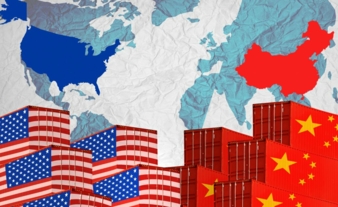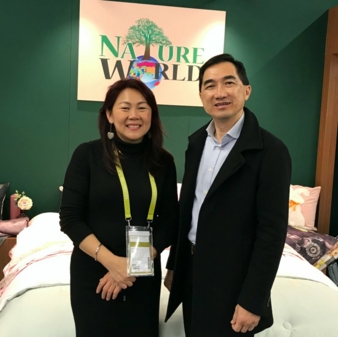12/02/2020 – Heimtextil — auf Deutsch lesen
Ceasefire in the trade war
Despite the first agreement, the US-China trade war has not yet been settled. At Heimtextil Frankfurt there was talk of a “ceasefire”.
The trade agreement recently signed in Washington between the USA and China – Phase 1 – is supposed to pave the way for a second, more extensive trade agreement, Phase 2. Given that it is no more than a “ceasefire” between the two big economies, the textiles trade is uncertain whether this first step will lead to a solution.
Exhibitors and trade visitors at Heimtextil, which took place in Frankfurt in January, widely believe that the USA sealed this first deal because the nation’s highest office bearer, President Donald Trump, wishes to appear to his supporters as a strong man in the presidential race 2020. The Chinese President Xi Jinping similarly wants to emerge from the trade conflict with a strong-man image.
Trade conflict lasting two years
There was general consensus among exhibitors at Heimtextil that the trade war, which has been raging for the past two years and can only end by mutual agreement, has wreaked havoc in world trade. Whilst China’s exports have suffered, suppliers from other countries such as Bangladesh, India, Pakistan, Vietnam, Malaysia and Indonesia appear to have profited from the conflict. American but also European importers are increasingly approaching suppliers from other countries, even though the US government has agreed in the Phase One agreement not to impose any new tariffs.
Annemarie Wright from New Jersey, who was keen to meet her Indian suppliers at the fair:
“The trade war has shocked to the core many American companies who import their textiles and apparel from China.”
Hassan Suleri, Deputy General Manager Marketing Sadhaqat Limited, Faisalabad, Pakistan (bed linen):
“Our most important markets are Europe and the USA. We’ve noticed an increase in the number of visitors, especially from the USA. I couldn’t tell you whether this has anything to do with the trade war, but I obviously can’t rule it out either.”
Other Asian exhibitors shared similar views. Nature World Sdn. Bhd., headquartered in Shah Alam, Malaysia, was “very happy” with the visitor turnout from North America, but also from Brazil, Columbia and similar. “Many North American buyers are wanting to diversify their imports. They are searching for new sources and suppliers in other Asian countries because they see the trade conflict as too risky.”
Companies from Malaysia considered reliable
“Malaysia is seen as a reliable supplier that delivers quality products,” stated Wendy Tan, Managing Director of Nature World. Her company specialises in bedding (blankets, pillows etc.). Even though the additional import tariffs in place since 2018 will, for the most part, continue to be enforced, German trade visitors to Heimtextil expect there to be “some relief” within the textiles trade. One German textiles importer was of the opinion that the pause could lead to an all-round détente.
Trump originally declared the trade war because China exports much more to the USA than the USA does to China. For cost reasons, China now also produces textiles and apparel in other countries, which are not subject to the punitive tariffs, enabling China to get around them.
The big American and European stores are having to change their buying strategies as production and import costs continue to rise and the supply chains are exposed to greater uncertainty. While the Phase One Agreement was welcomed by the United States Fashion Industry Association (USFIA), it has done little to allay widespread uncertainty, prompting the USFIA to call for the American government to put an end to the trade war.
China has, likewise, imposed tariffs on American products. Since the beginning of the trade war, the Chinese have collected tariffs to the order of US$ 12bn, totalling US$ 1.3bn in October alone.
No end in sight?
No-one knows when the trade war will finally be laid to rest – but it certainly will not reach its conclusion until after the US presidential election. If China fails to implement the agreement, the US President may well introduce additional tariffs. In a recent interview with broadcasting network CNBC, Finance Minister Steven Mnuchin alluded to this possibility. He also confirmed that existing tariffs would not be removed until the second agreement was firmly in place.
In a conversation with textile network, Zhang Tao, Secretary-General of the Chinese Council for the Promotion of International Trade – better known by the acronym CCPIT – conceded that 2019 had been a “difficult year” for the textiles industry. “Our textile exports to the USA suffered because of the punitive tariffs. The USA is our second biggest market after the EU. The American tariffs on apparel and finished products are higher than on fabrics,” stated Tao. Total apparel and textiles exports from China amounted to approximately US$ 268bn in 2019; in the same period, exports to the USA came to approximately US$ 40bn.
The trade war ignited a sense of panic among American and several European companies. Many importers dependent on Chinese suppliers are currently considering whether to move their focus away from China, to raise prices or modify the products they bring to market. In conversations with textile network, German entrepreneurs at Heimtextil emphasised that they welcomed the partial agreement because it signals a détente. At least, Phase One, they say, has temporarily ruled out the risk of “another global escalation of tariffs”. Talking to textile network, Olaf Schmidt, Vice President (Textiles/Textile Technology) of Messe Frankfurt, stated: “The uncertainty isn’t good for business because decision-makers have to plan in the medium to long term.” Even so, companies can still sell their products successfully when times are tough, especially with the help of good branding and quality. In conversations with textile network, several experts in the international textile trade stressed that price is not the only factor.
According to the Americans, China has committed in the unpublished agreement to raise total imports from the USA by US$ 200bn over the next two years. The year 2017 has been used as a benchmark when China imported US goods and services to the order of around US$ 190bn. An average increase of US$ 100bn per year represents a substantial leap. According to the US government, imports are also expected to rise after 2021 in order to “rebalance the trade relationship”.





